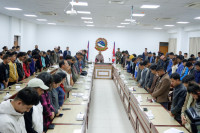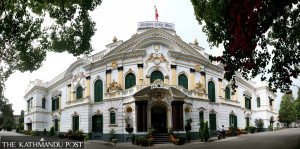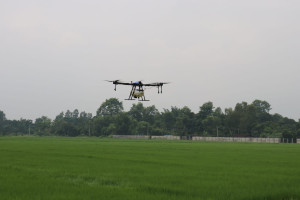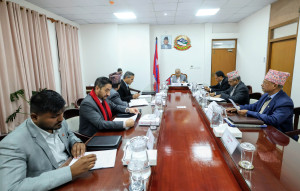Columns
Nepal earthquake, 10 years on
Disaster resilient structures are a step towards safeguarding Nepal for its future generations.
Arnaud Cauchois
The 2015 Nepal earthquake killed over 8,000 people, injured another 20,000 and displaced countless more and caused extensive damage. More than 7,000 schools were damaged, with almost 25,000 classrooms destroyed and another 10,000 requiring repairs, according to the UN.
Ten years later, Nepal’s transformation is evident—both in more resilient structures and in strengthened systems of preparedness, response and resilience. “Build Back Better” became the guiding principle. The Government of Nepal worked closely with development partners, civil society, local communities and the private sector to ensure that reconstruction wouldn’t merely replace what was lost but create something stronger, safer and more inclusive.
The results of those efforts can be seen today in earthquake-resilient homes, upgraded public buildings and safer schools.
One of the most significant transformations is the construction of safer, more resilient schools. With the support from the Asian Development Bank (ADB) and other development partners, the Government of Nepal rebuilt or retrofitted more than 7,500 schools with disaster-resilient designs and improved facilities. The school reconstruction process is a powerful example of how disaster recovery can strengthen long-term resilience.
The schools rebuilt with ADB support now offer safer, more inclusive learning environments to over 150,000 children across the country. Built to improved building and safety standards, they feature modern amenities, separate sanitation facilities for girls and boys, and, in some cases, solar panels and science labs.
Some schools piloted community-based retrofitting and fostered sustainable grassroots ownership by empowering municipalities to replicate the model using local funds. These investments will protect current students from future disasters and help ensure quality education for future generations. As part of the project, disaster risk management planning and awareness programmes have been implemented in communities surrounding the refurbished schools.
After the disaster, one of the top priorities was getting children back to school as quickly as possible. Returning students to safe classrooms was essential not only for their continuity of learning but also to restore a sense of normalcy. Timely damage assessments, site selection, building design and construction were all fast-tracked to minimise delays.
These efforts were part of ADB’s broader disaster response. A $3 million emergency grant was approved just two days after the earthquake to support rescue and relief materials for remote and severely affected districts.
A further $200 million was allocated to help rebuild and restore schools, roads and public buildings. This helped to rebuild 162 schools across eight districts, restore 400 kilometres of roads with climate-resilient features, and rebuild or repair nearly 120 government buildings. Perhaps most importantly, more than 600 officials were trained in disaster risk reduction, and the national building code was revised to enhance future preparedness.
That was followed by another $163 million Disaster Resilience of Schools Project. Under this initiative, damaged schools have been retrofitted to enhance their seismic resilience. In addition, ADB is extending its support to rebuild 30 schools damaged by the Jajarkot earthquake of November 3 2023, through the continuation of the ongoing project.
ADB also supported the rebuilding of more than two dozen heritage monuments, including Teen Dewal and Lakshmeswar along the Bagmati River in the Kathmandu Valley, which had suffered damage from both weather conditions and earthquakes over the years. These century-old buildings are now fully reconstructed with their original intricate stone and woodwork intact. They have been built back better using traditional materials and methods and are now able to withstand future seismic events.
Lessons learnt
The reconstruction underlined the importance of strong institutions, such as the National Reconstruction Authority, for delivering effective, coordinated emergency response and recovery.
A fast-track implementation strategy is essential in post-disaster settings to restore critical services quickly and efficiently. Standardised building designs, tailored to local climatic conditions, should be readily accessible to promote both structural resilience and aesthetic harmony.
Similarly, the need for speedy action must be balanced with safety and quality. Hastily built classrooms can pose serious risks. Taking time to ensure safe, well-constructed schools will help to avoid future repairs and protect lives. In a disaster-prone country like Nepal, rebuilding with earthquake resilience is essential. Though it may take longer, the investment safeguards future generations. A phased approach—starting with safe structures, followed by upgrades—may be the most effective strategy.
In the context of earthquake reconstruction or even new construction, it is also crucial to honour and preserve traditional Nepali architectural styles wherever possible, while integrating modern standards of safety and resilience. Embracing these traditional design elements as part of the 'build back better' approach ensures structural integrity as well as the preservation of cultural heritage.
These lessons matter. Future disasters are not a question of if, but when. Climate-related disasters triggered by natural hazards are intensifying across the region, posing extra threats to countries like Nepal, already grappling with seismic risks. This makes the shift from reactive recovery to permanent preparedness more urgent than ever.
More schools and infrastructure are being designed to withstand shocks. But disaster risk reduction must be an institutional priority—woven into every ministry’s budget, every municipality’s plan, and every contractor’s checklist. Earthquakes alone don't cause fatalities; weak, poorly constructed buildings do. That’s why ADB is mainstreaming disaster risk reduction and climate resilience in all infrastructure projects—to better protect lives when the next disaster happens.
As we mark a decade since the 2015 earthquake, we pause to acknowledge the lives lost and families displaced. We honour the strength with which Nepalis rebuilt—and continue to rebuild—their homes, schools, communities, families and futures.




 8.12°C Kathmandu
8.12°C Kathmandu















